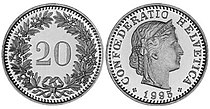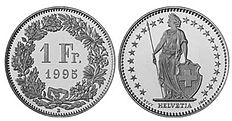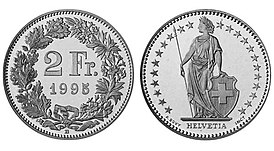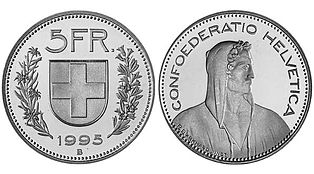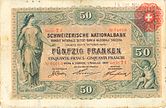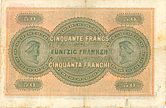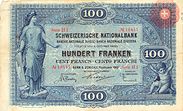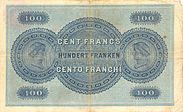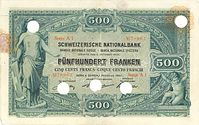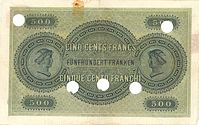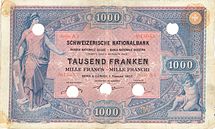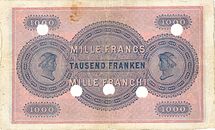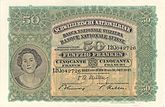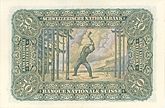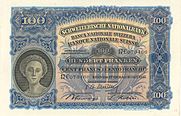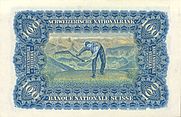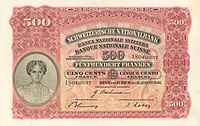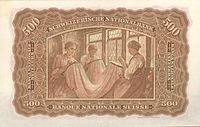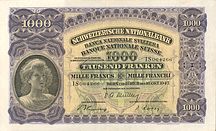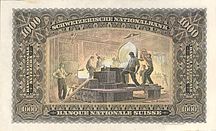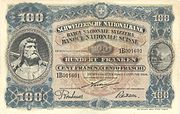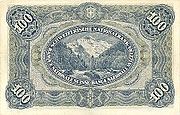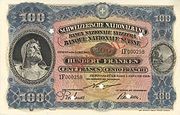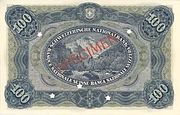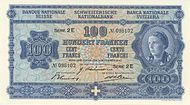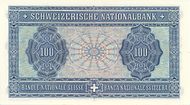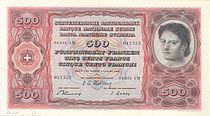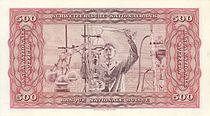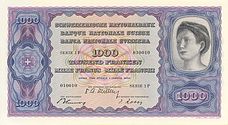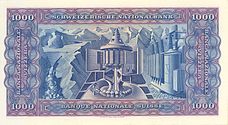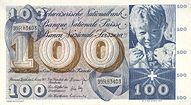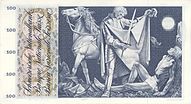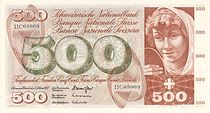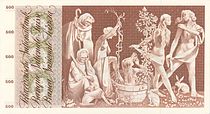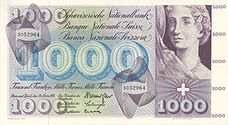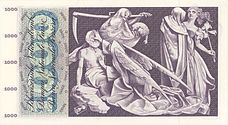Swiss franc
![]()
CHF is a redirect to this article. For other meanings, see CHF (disambiguation).
· Banknotes of the 9th series of 2016
· 
CHF 10
· 
CHF 20
· 
CHF 50
· 
CHF 100
· 
CHF 200
· 
CHF 1000
· Present coins in 1995 mintage
· 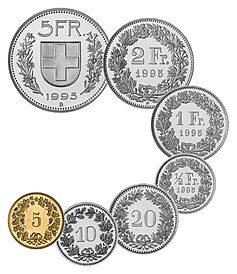
CHF 5, 2, 1, 1/2, -.20, -.10, -.05
The Swiss franc, also spelled Schweizerfranken in Swiss High German, (Swiss German Schwiizerfranke, French Franc suisse, Italian Franco svizzero, Rhaeto-Romanic![]() ) is the currency of the Swiss Confederation and the Principality of Liechtenstein issued by the Swiss National Bank and is divided into 100 centimes (French centimes, Italian centesimi, Rhaeto-Romanic raps). Its abbreviation according to ISO 4217 is CHF, according to Art. 1 MünzV in German Fr. , in the other languages fr. , for centime amounts the abbreviation Rp. (French c. , Italian ct. , Rhaeto-Romanic rp. ) is used for centime amounts. The decimal separator in the currency indication is a point, the currency abbreviation is prefixed (e.g. Fr. 12.35 or CHF 12.35).
) is the currency of the Swiss Confederation and the Principality of Liechtenstein issued by the Swiss National Bank and is divided into 100 centimes (French centimes, Italian centesimi, Rhaeto-Romanic raps). Its abbreviation according to ISO 4217 is CHF, according to Art. 1 MünzV in German Fr. , in the other languages fr. , for centime amounts the abbreviation Rp. (French c. , Italian ct. , Rhaeto-Romanic rp. ) is used for centime amounts. The decimal separator in the currency indication is a point, the currency abbreviation is prefixed (e.g. Fr. 12.35 or CHF 12.35).
Furthermore, the Swiss franc is the official currency in the Italian exclave of Campione d'Italia. In Büsingen am Hochrhein, the German exclave in Switzerland, payment is predominantly made in Swiss francs, although the euro is legal tender.
Swiss franc outside Switzerland
In 1924, the Swiss franc was also introduced in Liechtenstein, where it replaced the Austrian crown and Liechtenstein emergency money. However, Liechtenstein did not conclude an official currency treaty with Switzerland until June 19, 1980 ("Currency Treaty between the Swiss Confederation and the Principality of Liechtenstein").
See also: History of Liechtenstein#coinage
The official currency of the Italian exclave of Campione d'Italia is the Swiss franc. The German exclave of Büsingen am Hochrhein uses the euro as its official currency; however, trading is mostly done with the Swiss franc.
As a reserve currency, the Swiss franc plays a rather minor role.
As several international sports federations have their headquarters in Switzerland, prize money is paid in Swiss francs or fines are imposed in Swiss francs in many sports.
Coins
Circulation coins
Swiss coins are produced by the official Swissmint (formerly the Federal Mint).
The denominations, the diameter, the weight, the edge minting as well as the alloy are determined by the Federal Council (Art. 2 Coinage Ordinance), the FDF defines the tolerance limits regarding dimensions and the alloys.
The following coins are minted to date:
| Amount | Image | Motif | Metal | Diameter | Thickness | Mass | Edge embossing | Cost of sales | Nicknames |
| 5 centimes |
| Libertas head | 92 % Cu, 6 % Al, 2 % Ni | 17,15 mm | 1,25 mm | 1,8 g | smooth | 4,22 Rp. | Fünferli, Halbbatzen, Füfi |
| 10 centimes |
| Libertas head | 75 % Cu, 25 % Ni | 19,15 mm | 1.45 mm | 3 g | smooth | 6.63 Rp. | Tenner, Batzen, Zähni |
| 20 centime |
| Libertas head | 75 % Cu, 25 % Ni | 21.05 mm | 1.65 mm | 4 g | smooth | 8,47 Rp. | Zwanzigerli, Zwänzgerli, Zweibätzler, Zwänzgi |
| ½ Franconia |
| Standing Helvetia | 75 % Cu, 25 % Ni | 18,20 mm | 1,25 mm | 2,2 g | ribbed | 7,10 Rp. | Fufzgerli, Füfzgerli, Füfzgi |
| 1 franc |
| Standing Helvetia | 75 % Cu, 25 % Ni | 23,20 mm | 1.55 mm | 4,4 g | ribbed | 9.93 Rp. | Ei(n)fränkler |
| 2 francs |
| Standing Helvetia | 75 % Cu, 25 % Ni | 27,40 mm | 2.15 mm | 8,8 g | ribbed | 19,40 Rp. | Two-franc |
| 5 francs |
| Alphirt | 75 % Cu, 25 % Ni | 31.45 mm | 2.35 mm | 13,2 g | ★★★ DOMINUS PROVIDEBIT ★★★★★★★★★★ (deepened embossed from 1985 to 1993, otherwise prominent). | 36.30 Rp. | Fünfliber, Fünffränkler, Göttibatzen, Schnägg |
The edge is plain on 5, 10 and 20 centimes, ribbed on ½, 1 and 2 francs, and starred and inscribed "DOMINUS PROVIDEBIT" on 5 francs. The German translation of the Latin inscription is: Der Herr wird vorsorgen. This is a biblical quotation from the story of the sacrifice of Isaac.
Out of course are set and are no longer minted the single and double beater.
The country name is indicated on all coins as "Confoederatio Helvetica", the Latin name of the Swiss Confederation, or "Helvetia".
The oldest coins still in circulation today are the 10-centime coins from 1879. Of all the circulation coins in the world, they are by far the oldest to be produced to this day with the same motif and alloy.
The 2-franc coins have been minted - as the oldest - in the same motif since 1874 until today. However, the issues up to 1967 were withdrawn due to their silver alloy (today: cupro-nickel), as the silver alloy exceeded the nominal value. The same thing happened at the same time with all coin denominations from 50 centimes upwards (exception: in 1969 there were again 5-franc coins made of silver). Coins worth around 350 million Swiss francs were melted down in Switzerland and abroad during this period. Since 2004, the 10 (1932-1939) and 20 centime (1881-1938) coins made of pure nickel have also been withdrawn from circulation because vending machines cannot recognize them.
Today, all coins except the 5-centime coin (aluminum bronze since 1981) are alloyed in cupronickel.
The single-coupon piece, which had long ceased to play a role in payment transactions and whose production costs most recently amounted to 11 centimes, was withdrawn from circulation on January 1, 2007. The two-centime piece, which was minted until 1974, was taken out of circulation as early as 1978. At the same time as the single-coupon coin was abolished, the abolition of the five-coupon coin was also discussed. Since most of the reactions to this were negative and, among other things, a price increase was feared, these plans were dropped.
Commemorative coins
→ Main article: Commemorative coins of Switzerland and history of Liechtenstein#coinage
Switzerland has issued commemorative coins occasionally since 1936 and annually since 1974. Until 1991, these were five-franc coins, which were identical in technical specifications to the circulation coins and were valid for circulation, even though they were rarely encountered in payment transactions. Today, nominals of 10 francs (bimetal), 20 francs (20 g silver-copper alloy) and 50 francs (11.29 g gold-copper alloy, sold only above face value) are minted. Their face value is guaranteed by law, but they are not authorized for general payment transactions.
The "Currency Treaty Switzerland - Liechtenstein" of 1981 allows Liechtenstein, with the approval of the Federal Department of Finance (FDF), to mint its own coins and put them into circulation. This allows Liechtenstein to mint commemorative coins for special occasions. For example, two types of coins with a nominal value of 10 and 50 francs were minted for the 200th anniversary of the Principality's sovereignty in 2006. However, these are only valid as means of payment in Liechtenstein.
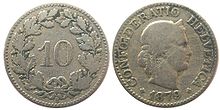
10 centime coin from 1879
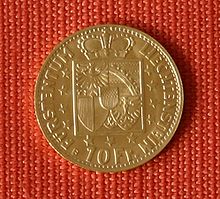
Liechtenstein 10 franc gold coin from 1946 commemorating Prince Franz Josef II, 2.90 g fine gold, minted according to the standard of the Latin Mint Union
Banknotes
Banknotes were first issued by commercial and cantonal banks; in 1907, the newly founded Swiss National Bank (SNB), as the central bank, was given the sole right to issue banknotes (note monopoly). The first series (interim notes), which was introduced immediately, was still based on designs from abroad, supplemented by Swiss national emblems. In 1909, Orell Füssli printed trial banknotes for the SNB, which were produced by several printers on the basis of domestic designs and introduced by the SNB as a second series from 1911. In the 1970s, with the sixth series, Orell Füssli's security printing department became the sole printer for all Swiss banknotes. The production costs of the 8th series amounted to around 30 centimes per banknote.
Liechtenstein has never issued banknotes in Swiss francs and has no right to do so under the current Swiss-Liechtenstein Currency Treaty.
Tabular overview
| Series | Introduction | Recall | exchangeable until | Designer | Comments |
| 1. | 1907 | 01.07.1925 | 01.07.1945 | Josef Storck and Albert Walch | Transition Notes |
| 2. | 1911 | 01.10.1958 | 01.10.1978 | Eugène Burnand, Ferdinand Hodler and S. Balzer | the 5-franc note was recalled only in 1980 and lost its validity in 2000 |
| 3. | 1918–1930 | 1925/1956 | 1945/1976 | Orell Füssli | so-called war notes, only 2 notes issued |
| 4. | (1938) | - — | - — | Victor Surbek and Hans Erni | Reserve series, never been in circulation |
| 5. | 1956–1957 | 01.05.1980 | 01.05.2000 | Pierre Gauchat and Hermann Eidenbenz | |
| 6. | 1976–1979 | 01.05.2000 | Unlimited | Ernst and Ursula Hiestand | |
| 7. | (1984) | - — | - — | Elisabeth and Roger Pound | Reserve series, never been in circulation |
| 8. | 1995–1998 | 30.04.2021 | Unlimited | Jörg Zintzmeyer | replaced by the 9th series |
| 9. | 2016–2019 | Unlimited | Manuela Pfrunder | circulating |
In each case, the banknotes are valid as legal tender until they are recalled, after which they can be exchanged at their face value at the Swiss National Bank. There were different time limits for this. In 1921, a period of 20 years from recall was introduced. From the 6th series onwards, the banknotes no longer lose their value, but can be exchanged for an unlimited period.
Validity period of the banknotes
Since 2020, all banknotes from the sixth banknote series of 1976 onwards can be exchanged at the SNB at face value for an unlimited period of time, even after they have been recalled. Until the end of 2019, the rule was that after the issue of the last note value of a new series, the Swiss National Bank announced the recall of the old series in each case. After that, the banknotes could still be exchanged at the SNB at par value for a period of twenty years, after which the notes were worthless.
In April 2017, the Swiss Federal Council, in agreement with the Swiss National Bank, proposed to abolish the exchange deadline for old banknotes. The Swiss Council of States did not initially follow this proposal, as this would have meant that the cantons would have had to forgo revenue. Until then, the SNB paid the equivalent value of the notes that were not exchanged into the Swiss Fund for Assistance in the Event of Uninsurable Natural Disasters (Fondssuisse). However, the Council of States proposed that only one-fifth of this should go to the fund, with the remainder distributed one-third to the federal government and two-thirds to the cantons. In June 2019, the Council of States relented, so that since then banknotes from the sixth series onwards can be exchanged for an unlimited period of time - as in many other countries. The revision of the law came into force on January 1, 2020 (Art. 9 par. 3 and 4 WZG).
Banknote series
All note illustrations of all series below are to scale with each other.
First series from 1907
The first series consisted of the notes: 50, 100, 500 and 1000. The banknote for 1000 francs was a very high value by the standards of the time. According to today's purchasing power, it would correspond to a banknote worth 11,800 francs. The notes were issued in 1907 when the National Bank was founded as "interim notes" (interimsnoten), since there was too little time between the founding of the National Bank and the note issue to create new notes. 1st issue: 20 June 1907, recall: 1 July 1925, valid until: 30 June 1945.
The copper plates were made by Bradbury Wilkinson and Company in London, the letterpress and numbering was done by Stämpfli & Co. and the copperplate printing was done by Benziger in Einsiedeln.
| Amount | Front | Back | Portrait | Motif | Formatin | Date of issue |
| Fr. 50 |
|
| Helvetia | Ornaments | 103 × 166 | 20 June 1907 |
| Fr. 100 |
|
| Helvetia | Ornaments | 116 × 183 | 20 June 1907 |
| Fr. 500 |
|
| Helvetia | Ornaments | 126 × 199 | 20 June 1907 |
| Fr. 1000 |
|
| Helvetia | Ornaments | 132 × 215 | 20 June 1907 |
Second series from 1911
The second series of 1911 consisted of the 5, 10, 20, 40, 50, 100, 500 and 1000 notes. The series was valid for more than 67 years, but the 10 and 40 notes were never in circulation. 1st issue: September 16, 1911, recall: October 1, 1958, valid until: September 30, 1978. The 5 note was not recalled until May 1, 1980 and was valid until April 30, 2000.
The 1000, 500, 100, 50 and 10 notes were printed at Waterlow in London. The 40, 20 and 5 note were printed by Orell Füssli.
| Amount | Front | Back | Portrait | Motif | Formatin | Date of issue |
| Fr. 5 |
|
| William Tell | Ornaments, rosette | 72 × 125 | August 3, 1914 |
| Fr. 10 |
|
| Neuchâtel | Ornaments, rosette | 82 × 135 |
|
| Fr. 20 |
|
| Vreneli | Ornaments, rosette | 95 × 163 | July 31, 1914 |
| Fr. 40 |
|
| Arnold Winkelried | Ornaments, rosette | 82 × 144 |
|
| Fr. 50 |
|
| Woman head in medallion | Woodcutter (Ferdinand Hodler) | 106 × 165 | December 22, 1911 |
| Fr. 100 |
|
| Woman head in medallion | Mower (Ferdinand Hodler) | 115 × 181 | September 16, 1911 |
| Fr. 500 |
|
| Woman head in medallion | Hand embroiderers (Eugène Burnand) | 125 × 200 | December 24, 1912 |
| Fr. 1000 |
|
| Woman head in medallion | Foundry (Eugène Burnand) | 131 × 216 | September 16, 1911 |
Third series from 1918
The third series consisted of several notes created during the years 1918 to 1930 as "war notes". It consists of three different 20 notes and two different 100 notes, of which only one was issued at a time.
The 100 note issued was recalled as early as July 1, 1925, and became worthless on July 1, 1945. The 20 note was recalled on April 1, 1956 and became worthless on April 1, 1976.
| Amount | Front | Back | Portrait | Motif | Formatin | Date of issue |
| Fr. 20 |
|
| Johann Heinrich Pestalozzi | Swiss cross | 86 × 143 | July 15, 1930 |
| Fr. 20 |
|
| Johann Heinrich Pestalozzi | Swiss cross | 86 × 143 | - – |
| Fr. 20 |
|
| Freiburg | Ornaments and rosette | 88 × 141 |
|
| Fr. 100 |
|
| William Tell | Ornaments, rosette and virgin massif | 115 × 180 | September 27, 1918 |
| Fr. 100 |
|
| William Tell | Ornaments, rosette and virgin massif | 115 × 180 |
|
Fourth series from 1938
The fourth series consisted of the notes 50, 100, 500 and 1000. It was a reserve series printed by Orell Füssli. It was never issued. For the 500 note, it remained a proof. The 50, 500 and 1000 notes were designed by Hans Erni, the 100 note by Victor Surbek.
| Amount | Front | Back | Portrait | Motif | Formatin | Date of issue |
| Fr. 50 |
|
| Woman head in medallion | Taurus | 96 × 167 | - – |
| Fr. 100 |
|
| Haslital woman in medallion | Guilloche and value digit | 106 × 190 | - – |
| Fr. 500 |
|
| Woman head in medallion | Chemistry | 116 × 210 | - – |
| Fr. 1000 |
|
| Woman head in medallion | Turbine | 125 × 228 | - – |
Fifth series from 1956
The fifth series consisted of the notes 10, 20, 50, 100, 500 and 1000. 1st issue: staggered from March 29, 1956, recall: May 1, 1980, valid until: April 30, 2000.
The 10 and 20 notes were designed by Hermann Eidenbenz and printed by Orell Füssli in Zurich, the higher-value notes were designed by Pierre Gauchat and printed by Waterlow and De La Rue respectively.
| Amount | Front | Back | Portrait | Motif | Formatin | Date of issue |
| Fr. 10 |
|
| Gottfried Keller | Clove Root | 75 × 137 | October 1, 1956 |
| Fr. 20 |
|
| Henri Dufour | Silver Thistle | 85 × 155 | March 29, 1956 |
| Fr. 50 |
|
| Girl head | Apple harvest | 95 × 173 | June 14, 1957 |
| Fr. 100 |
|
| Boy's Head | St. Martin | 105 × 191 | June 14, 1957 |
| Fr. 500 |
|
| Woman head | Fountain of youth | 115 × 210 | June 14, 1957 |
| Fr. 1000 |
|
| Woman head | Dance of Death | 125 × 228 | June 14, 1957 |
Sixth series from 1976
The sixth series was designed by Ernst and Ursula Hiestand and printed by Orell Füssli in Zurich. It consisted of note denominations of 10, 20, 50, 100, 500 and 1000 Swiss francs. The banknotes were issued on a staggered basis starting October 4, 1976, and were recalled on May 1, 2000. The notes can be exchanged without restriction at the Swiss National Bank at full face value.
| Amount | Front | Back | Portrait | Motif | Formatin | Date of issue |
| Fr. 10 |
|
| Leonhard Euler | A water turbine, our solar system and the ray path in a lens system | 66 × 137 | November 5, 1979 |
| Fr. 20 |
|
| Horace-Bénédict de Saussure | A mountain landscape, a group of mountaineers (probably after a work by Henri L'Evêque CH-NB - Monsieur Desaussure son fils & ses guides arivant au glacier du Tacul au grand Géant où ils ont habité 17 Jours Sous des Tentes en Juillet 1788 - Graphics Views of Places and Landscapes - GS-GRAF-ANSI-F-39.tif) and ammonites | 70 × 148 | April 4, 1979 |
| Fr. 50 |
|
| Conrad Gessner | an owl, a primrose and stars | 74 × 159 | October 4, 1978 |
| Fr. 100 |
|
| Francesco Borromini | The steeple and floor plan of Sant'Ivo alla Sapienza | 78 × 170 | October 4, 1976 |
| Fr. 500 |
|
| Albrecht von Haller | A schematic representation of breathing and a muscle figure | 82 × 181 | April 4, 1978 |
| Fr. 1000 |
|
| Auguste Forel | Three ants and the vertical section through an anthill | 86 × 192 | April 4, 1978 |
Seventh series from 1984
It was designed in the 1980s and formed the reserve series. The appearance and data of these banknotes were not intended for the public (so-called secret reserve). The notes of this series would have been used in case the notes currently in circulation were counterfeited en masse. This was the last reserve series. Instead of a reserve series, the security system was continuously developed for the eighth series. In the meantime, the appearance of the seventh series has also been published. On this series, the same people are depicted (albeit from other designs) as on the sixth series, with the exception of Auguste Forel, who was replaced by Louis Agassiz.
| Amount | Front | Back | Portrait | Motif | Formatin | Date of issue |
| Fr. 10 |
|
| Leonhard Euler | The gamma function, our solar system and a table of numbers | 66 × 137 | No output |
| Fr. 20 |
|
| Horace-Bénédict de Saussure | A hygrometer and the Montblanc | 70 × 148 | No output |
| Fr. 50 |
|
| Conrad Gessner | A golden eagle, an animal metamorphosis and a Latin text | 74 × 159 | No output |
| Fr. 100 |
|
| Francesco Borromini | The floor plan of San Carlo alle Quattro Fontane, the spire of Sant'Ivo alla Sapienza and a peace dove | 78 × 170 | No output |
| Fr. 500 |
|
| Albrecht von Haller | An anatomy chart from the 18th century and an X-ray of the human ribcage | 82 × 181 | No output |
| Fr. 1000 |
|
| Louis Agassiz | The head and skeleton of a perch | 86 × 192 | No output |
Eighth series from 1995
The eighth series of banknotes, which was introduced from 1995, comprises six denominations featuring portraits of Swiss cultural figures, a significant proportion of whom had worked abroad. The notes were issued between 1995 and 1998 and were recalled as of April 30, 2021. The notes can be exchanged without restriction at the Swiss National Bank at full face value.
| Amount | Front | Back | Portrait | Motif | Formatin | Date of issue |
| Fr. 10 |
|
| Le Corbusier (Architect) | Floor plan of the government quarter of the Indian city Chandigarh | 74 × 126 | April 8, 1997 |
| Fr. 20 |
|
| Arthur Honegger (composer) | Pacific 231 | 74 × 137 | October 1, 1996 |
| Fr. 50 |
|
| Sophie Taeuber-Arp (visual artist) | Tête Dada, 1919 | 74 × 148 | October 3, 1995 |
| Fr. 100 |
|
| Alberto Giacometti (visual artist) | L'Homme qui marche I | 74 × 159 | October 1, 1998 |
| Fr. 200 |
|
| Charles-Ferdinand Ramuz (writer) | Lac de Derborence/Diablerets, Lavaux | 74 × 170 | October 1, 1997 |
| Fr. 1000 |
|
| Jacob Burckhardt (art historian) | Palazzo Strozzi, Florence (detail of the facade) | 74 × 181 | April 1, 1998 |
These notes replaced the previous series from 1995 to 1998. The issue of a 500-franc banknote was dispensed with, but a new 200-franc banknote was introduced.
Ninth series of 2016
The ninth banknote series was introduced in stages from April 2016 to September 2019. The design competition was won by Manuel Krebs, however runner-up Manuela Pfrunder was commissioned to continue her design. The date for the introduction was originally planned for fall 2010. In order to have more time for the development of new security technologies, the date was initially postponed to 2012, as there was still no security deficiency in the current banknote series. In February 2012, the SNB announced a further delay of at least one year due to technical problems.
However, the issue date was changed again at the end of 2012; the rollout is now scheduled to take place between April 2016 and 2019.
The first to be presented to the public at a media conference on April 6, 2016, and issued from April 12, 2016, was the new 50 note, which was voted the most beautiful note of 2016 by the International Banknote Society. The other notes were put into circulation at intervals of half a year or a whole year.
| Amount | Front | Back | Motif | Formatin | Date of issue |
| Fr. 10 |
|
| Time, the organizing side of Switzerland: | 70 × 123 | October 18, 2017 |
| Fr. 20 |
|
| Light, the creative side of Switzerland: | 70 × 130 | May 17, 2017 |
| Fr. 50 |
|
| Wind, the eventful side of Switzerland: | 70 × 137 | April 12, 2016 |
| Fr. 100 |
|
| Water, the humanitarian side of Switzerland: | 70 × 144 | September 12, 2019 |
| Fr. 200 |
|
| Matter, the scientific side of Switzerland: | 70 × 151 | August 22, 2018 |
| Fr. 1000 |
|
| Language, the communicative side of Switzerland: | 70 × 158 | March 13, 2019 |
Anti-counterfeiting
The current ninth series banknotes are among the most counterfeit-proof in the world. They have up to 18 different security features to make counterfeiting virtually impossible. The paper produced by Landqart is made from by-products of cotton processing (so-called linters).
Specimen
If Swiss banknotes are reproduced, for example for use as test samples, play money or for advertising purposes, the imprint "SPECIMEN" (German: "Probe"/"sample") is mandatory on the Swiss franc bills, with the length of the word representing at least 75% of the banknote and the width 15%. The imprint may be omitted if it can be clearly distinguished from genuine notes by other features (such as size, etc.).
The 1000-franc note as "most expensive note
The 1000 franc banknote has been issued by the Swiss National Bank since the first series (1907). It has always been a banknote of exceptionally high value. In 1907, for example, the 1000-franc note had a present-day value, adjusted for inflation, of 11,800 francs.
Of the better-known currencies or reserve currencies, the 1,000-franc bill is by far the banknote in regular circulation worldwide with the highest value or purchasing power, measured by the exchange rate to other currencies. For example, the current value of the highest euro banknote still in regular circulation is EUR 500 (= approx. CHF 550), the highest US dollar bill still in regular circulation is US$ 100 (= approx. CHF 92), the highest pound sterling note issued by the Bank of England is GBP 50 (= approx. CHF 64) or the highest Japanese yen note is JPY 10,000 (= approx. CHF 83).
Taking all currencies into account, the 1,000-franc bill is the banknote in regular circulation worldwide with the second-highest value or purchasing power, after the 10,000-Brunei dollar note (approx. 6800 francs). If banknotes no longer issued and no longer in regular circulation but still valid are taken into account, there are "more expensive" banknotes in several other currencies, e.g. a 10,000 Singapore dollar note exists, but has not been issued since 2014. In the case of the U.S. dollar, bills with denominations of US$1,000, US$5,000, and US$10,000 were issued until 1945 and recalled in 1967, but they remain legal tender. Also printed, never in circulation, but legal tender is a note with a value of US$100,000.
With the advent of electronic payments, the economic need for banknotes with very high value / purchasing power decreased. Despite this, the circulation of the 1,000-franc note has risen steadily in recent years: While there were 20 million "thousands" in circulation in 2004, there were already 38 million in 2014. Presumably, the 1000-franc note is increasingly used for the physical storage of assets in safe deposit boxes or outside financial institutions by people who distrust banks, want to avoid negative interest rates or who - illegally - do not want to pay taxes on their assets. In the criminal environment, too, especially in the case of organized crime, cash is preferred both for handling sometimes extremely costly transactions (e.g. drug trafficking) and as an investment, for which the 1,000-franc note seems particularly suitable. Since the Swiss franc is also considered a safe currency, the note is also attractive to foreign (non-Swiss) criminals. For the purpose of combating namely money laundering, terror financing and drug trafficking, the 500-euro bill was abolished in April 2019. There have also been isolated calls for this in Switzerland. However, as the Swiss are considered to be particularly cash-savvy and the effectiveness in fighting crime is questionable, there are no concrete intentions to abolish the 1000-franc bill; on the contrary, on March 13, 2019, just 2 months before the abolition of the 500-euro bill, the Swiss National Bank issued the 1000-franc bill for the first time in the current, 9th banknote series
Parallel to the 1000-franc bill as the "most expensive" banknote, the five-franc piece is one of the "most expensive" exchange coins.
Banknotes in circulation
In 2017, the average banknotes in circulation amounted to 76,507,131,570 Swiss francs. This sum was spread over a total of 449,531,533 banknotes. The highest share in terms of value was accounted for by the 1000 Swiss franc note with 47,313,516,000 Swiss francs (61.8%). This indicates that a large proportion of cash is used as a store of value outside payment transactions. In terms of number of units, the 100-franc note was the most frequently encountered: There were 125,486,986 100-franc banknotes in circulation, representing 27.9% of the total number of Swiss banknotes.
Colloquial terms
The franc is often called Stutz in the colloquial language, the dialects of German-speaking Switzerland. There are various explanations for this; for example, a famous mintmaster in Fürth at that time who came from Switzerland was called Conrad Stutz. According to another interpretation, Stutz, stutzen or verstutzen used to mean "exchange", "trade" or "squander". Another casual word is Stein (Swiss German Stei). For the colloquial names for the coins, see the table in the section on circulation coins.
In the French-speaking world, the colloquial term for the franc is balle (plural: balles), which was also common in France for the French franc.
See also
- Goldvreneli


